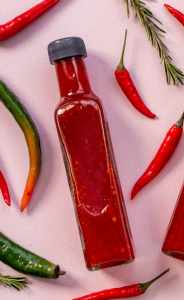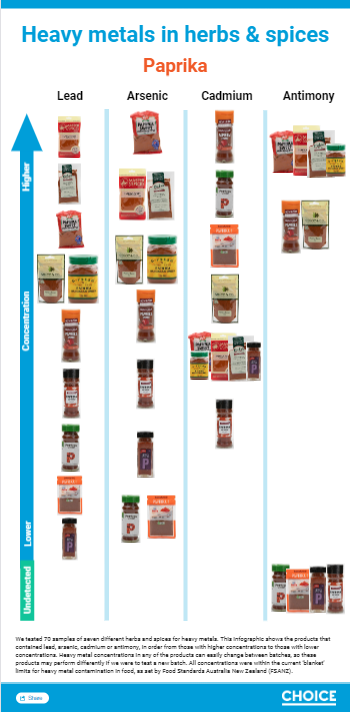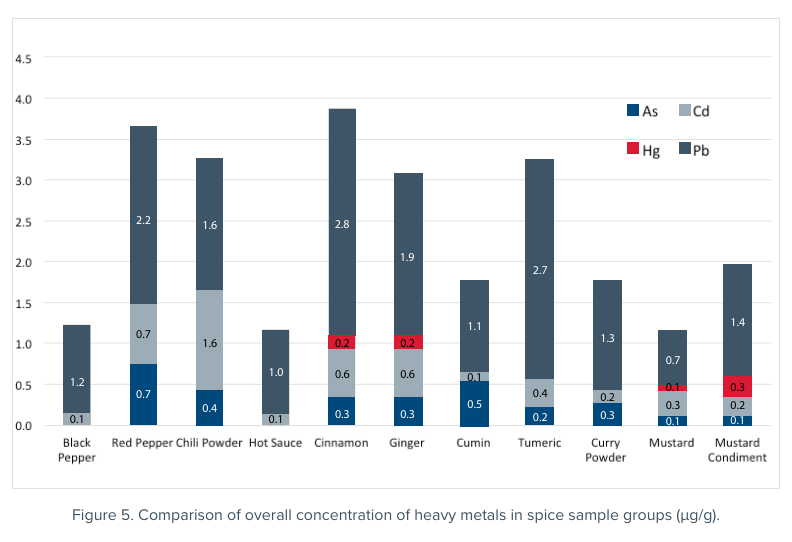Toxic Metals in Chilli Sauces, Turmeric and other spices.
 When searching for the exposure have you asked whether your patient loves Chilli sauces?
When searching for the exposure have you asked whether your patient loves Chilli sauces?
” In March this year, the US Food and Drug Administration warned that investigators detected roughly 2 to 3 parts per million of lead in Cinnamon. It is known that some spice suppliers intentionally add lead chromate to enhance the colour or increase the product weight! “
This article reveals other spices from a US Laboratory white paper and an Australian investigation!
Dried Chilli and Hot Sauces
A recent white paper produced by Spex Analytical Laboratories (USA) looked at whole and ground spice samples from seven spice families purchased online and from health food stores, grocery stores, retail chain stores, and discount stores. The samples ranged in price from $1USD per bottle to more than $20USD per ounce. Some products were designated as ‘organic‘. In addition to the spices, related teas, sauces and dietary supplement capsules featuring spices were purchased for study. The products were tested for heavy metal contamination using an ICP-MS.
Some of the highest lead levels, in terms of exposure, were in the commercially prepared red pepper sauces packaged in individual servings of about 10 g per packet. The serving size of two packets or 20 g was used to compare heavy metal concentrations. Two packets of a Chinese fast food hot sauce contained 20.6 μg of lead and 63 μg of chromium, contributing to almost 30% of an adult’s allowable daily limit for each element. Lead and chromium were consistently found in all the hot sauces tested. Some of the samples also included measurable amounts of arsenic and cadmium.
The dry spices had the highest concentrations of lead and chromium, but the typical serving of dry spices minimized the exposure to these concentrations. The chilli sauces had lower overall concentrations of heavy metals in comparison but would result in higher exposure levels when considered within the context of serving size. In the case of some hot sauce packets, two packets would contain over a quarter of an adult’s exposure to chromium and lead for the day.
Red pepper, when compared to the other studied spices, contained some of the highest overall concentrations of heavy metals (only exceeded by some cinnamon and turmeric samples for the highest levels of lead). Red pepper and chilli powder blend samples did contain the highest amounts of arsenic and cadmium found in all the spices. The only heavy metal not found in significant concentrations in red pepper spices was mercury.

Australian Herbs and Spices
In October 2022 a CHOICE review found heavy metals in Australian supermarket herbs and spices (including organic brands). A batch of 70 dried herbs and spices from a variety of popular brands were tested and all samples had traces of lead and many had traces of arsenic, antimony, cadmium and mercury, with some higher than others. The Spices included basil, cumin, ginger (ground), oregano, paprika, thyme and turmeric.
CHOICE concluded that as herbs and spices are consumed in small amounts Australians “shouldn’t be overly concerned with the results, but are advised to try to minimise their total exposure to heavy metals found in food and in their environment”. To read the CHOICE article click here.
Food Standards Australia New Zealand (FSANZ), the food regulatory body, sets maximum levels of heavy metals in certain food categories. As dried herbs and spices do not fall into any of the categories, they need only comply with the overall maximum levels, which are high! FSANZ states that: “Food must be safe and suitable for human consumption. For example, the concentration of contaminants and natural toxicants should be kept as low as reasonably achievable.”
Should we be concerned?
For an adult where the heavy metal exposure is “below calibration” this would not be of concern. It’s hard these days to find many of those! Where there is a level of heavy metal exposure, it may be required to limit the usage of chilli-based sauces whilst working with the patient to regain body balance.
Regular assessment with HTMA Pathology is key for maintaining optimal health.
The CHOICE review highlights the issue in Australia with the lack of standards set for herbs and spices and how this may potentially raise the level of heavy metal toxicity even in the healthiest diets. Not many of us would have considered the hot sauces or “herbs and spices”!
Identifying if your patient has a toxicity, and which mineral or minerals are of concern is your starting point.
Resolving where and when contamination occurred, and whether it is ongoing is paramount. The CHOICE review also highlights the requirement of Antimony testing!
Written by:
Ann Wine
InterClinical Laboratories


No Comments
Sorry, the comment form is closed at this time.